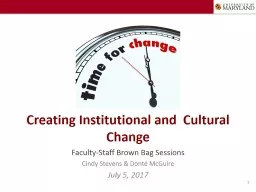

FacultyStaff Brown Bag Sessions Cindy Stevens amp Donté McGuire July 5 2017 1 Welcome Check website for updates wwwugstumdedusolutionsinactionhtml Volunteers Checkin 2 Session Goals ID: 778008
Download The PPT/PDF document "Creating Institutional and Cultural Cha..." is the property of its rightful owner. Permission is granted to download and print the materials on this web site for personal, non-commercial use only, and to display it on your personal computer provided you do not modify the materials and that you retain all copyright notices contained in the materials. By downloading content from our website, you accept the terms of this agreement.
Slide1
Creating Institutional and Cultural Change
Faculty-Staff Brown Bag SessionsCindy Stevens & Donté McGuire July 5, 2017
1
Slide2Welcome
Check website for updates:
www.ugst.umd.edu/solutionsinaction.htmlVolunteers
Check-in
2
Slide3Session Goals
Identify your sources of power
Clarify brakes and gas pedals for change
Begin imagining possible action for change in your unit
3
Slide4What is power?
4
Any resource you have that
people value.
What are potential power resources?
Formal authority
Social network
Information or knowledge
Rewards and sanctions
Reputation
Others?
Slide5Organizations are networks
of people5
They have different roles:
Decision makers
: have power or authority to decide.
Influencers
: offer
advice
& suggestions to decision makers.
Stakeholders
: are directly or indirectly affected by
changes.
Bystanders
: are not directly affected by change but can observe
and
comment.Each role has power!
Slide6What are your sources of power at work?
6
What resources do
you
have that other people value?
What
could
you do to
increase
your power to create change?
Slide7Gas
pedals and brakes on change
Some brakesUMD structure
Culture of academe
Uncertain vision of needed changes
Gas pedals
Sense of urgency
Interest
among staff and faculty
Student demands for
change
Other factors?
7
Slide8Spiders, starfish and organizations
8
How do spiders and starfish differ?
Starfish legs duplicate all their internal organs; if you cut one off, it grows back.
Decentralized organizations
are like starfish—the units act independently. To create change, you have to change every unit.
Slide9Culture of academe
Universities evolved from European monasteriesHierarchy/tradition run deepR1 faculty tend to focus
on their disciplinesIdeas are more accepted when described in ways that “fit”
9
Slide10Uncertain vision of change
10
All things are created twice: first mentally, then physically.
The key to creativity is to
begin with the end in mind
, with a vision and a blue print of the desired result.
Stephen Covey
(1932-2012)
Slide11Begin with the end in mind
What would be different if your unit fully welcomed & accepted people from all races and ethnicities?
Specifically, how would you know?
11
Slide12Small Group Discussion
In small groups, please discuss
:
What
1-2 actions would your unit
need to
do/do differently?
How
might
those changes “fit” within the culture of
academe & your unit?
Who would need to be involved? How could you enlist their help?
12
Slide13Debrief Discussion
13
What ideas did you come up with?
If you email your ideas to us, we’ll combine and post them online.
cstevens@rhsmith.umd.edu
donte@terpmail.umd.edu
longky@terpmail.umd.edu
donte@terpmail.umd.edu
Slide14Steps to create organizational change
14
Create a sense of urgency
Form group to push for change
Develop a clear vision of change
Communicate the vision
Empower people to act on the vision
Create momentum--find early “wins”
Build on that momentum over time
Anchor changes in the structure & culture
Slide1515